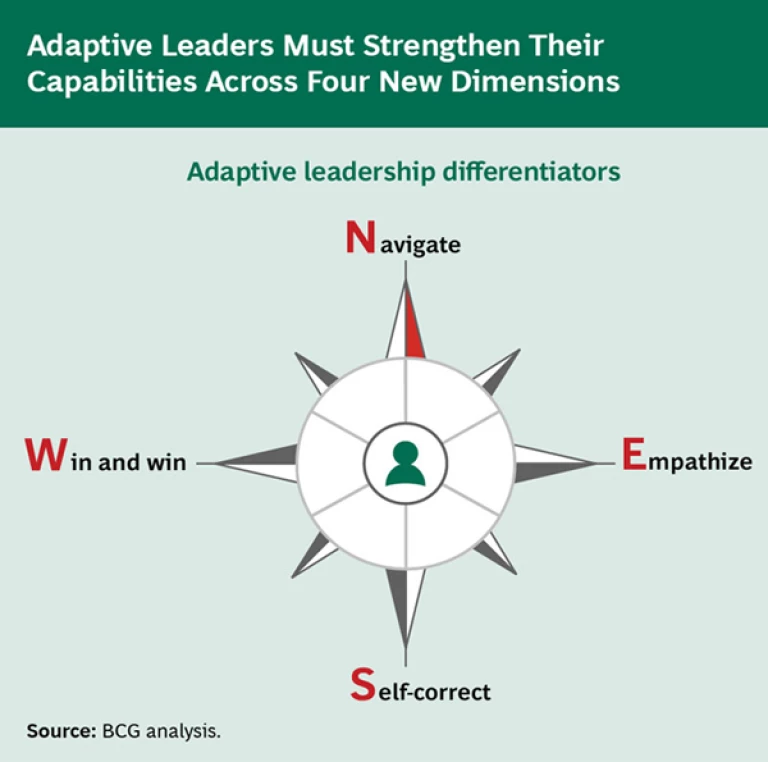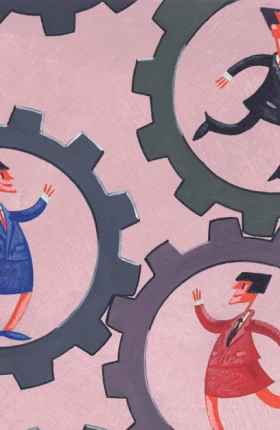We commonly think of leaders as strong personalities who imprint their will on compliant organizations. Increasingly, however, business executives are finding something lacking in this view of the leader as hero. As the former CEO of IBM, Sam Palmisano, wrote in “The Globally Integrated Enterprise,” an essay in Foreign Affairs, “Hierarchical, command-and-control approaches simply do not work anymore. They impede information flows inside companies, hampering the fluid and collaborative nature of work today.”
Our research and experience suggest that the fundamental shifts in today’s business environment compel us to rethink the nature of strategy, organization, and consequently, leadership. Consider the following trends:
Turbulence and uncertainty have undermined the effectiveness of long-range forecasting and traditional strategic planning in many industries.
How can leaders chart a course when they cannot predict the outcomes of their choices?
Companies are increasingly organized into interdependent, multicompany ecosystems—a result of lower transaction costs and “deconstruction.”
When company boundaries are thus blurred, who leads whom?
The pervasiveness and economics of digital communication and computation have made every business an information business.
In such an environment, how can leaders ensure that their organizations are reading the right signals and acting on them?
Society’s increasing interest in the social and ecological impacts of business makes it imperative for companies to consider the broader value and overall cost of their strategies.
How can leaders ensure that social and economic vectors are aligned?
Trust in big business has steadily eroded.
How can leaders regain society’s confidence? How can they harness the creativity and passion of the work force in pursuit of advantage?
The nature of competition has become more diverse. Some environments are mature and predictable, while others are highly uncertain.
How do leaders ensure that they are taking the right approach—or the right mosaic of approaches—for the specific challenge at hand?
These shifts in the business environment call for adaptive strategies and organizations, which in turn require adaptive approaches to leadership. Adaptive leaders create the conditions that enable dynamic networks of actors to achieve common goals in an environment of uncertainty.
Dimensions of Adaptive Leadership
Adaptive leadership can be distinguished from more traditional models in at least four dimensions, as the exhibit illustrates.
Following we describe a number of actions companies can take to support each of those dimensions.
Navigating the Business Environment. Adaptive leaders must embrace uncertainty and adopt new approaches if they are to chart a course amid today’s turbulent conditions.
Manage the context in which actors interact, not the instruction set. In an uncertain world, rigid rules are counterproductive. The best solution will arise through learning and adapting to change over time. Netflix CEO Reed Hastings advises in his firm’s “ Reference Guide on our Freedom & Responsibility Culture ”: “Avoid chaos as you grow with ever more highly performing people, not with rules.”
Cultivate a diversity of perspectives to generate a multiplicity of options. Whereas traditional models of leadership may emphasize alignment, some adaptive leaders make dissenting opinion compulsory. Perhaps the most famous example of embracing opposing views comes from Abraham Lincoln, who deliberately named his rivals to his cabinet. Leaders are more likely to find a diversity of perspectives at lower levels in the organization, where employees confront external realities directly and are likely to raise critical questions. For this reason, adaptive leadership deemphasizes hierarchy.
Allow leadership to be shared and to emerge from the given context. In a volatile world, no single person can lead at all times and in all situations. The role of leader therefore should be assumed by the person or group best positioned to guide a specific decision. An executive at W.L. Gore & Associates, the global technology manufacturer, was quoted in The Future of Management as saying: “We vote with our feet. If you call a meeting, and people show up, you’re a leader.”
1 1 Gary Hamel with Bill Breen, “ Building an Innovation Democracy: W.L. Gore,” excerpted in The Future of Management, Harvard Business School Press, 2007. Constantly question the world around you. Adaptive leaders are always looking outward and realigning their organizations with a shifting environment. They read between the lines to intuitively grasp patterns that may be masked by complexity. They test their own assumptions by running thought experiments. An example is highlighted in the biography of former Intel president Andy Grove, who asked the then CEO: “If we got kicked out and the board brought in a new CEO, what do you think he would do?”
2 2 Richard Tedlow, Andy Grove: The Life and Times of an American Business Icon, Penguin Group, 2007.
Leading with Empathy. Adaptive leaders create a shared sense of purpose and manage through influence rather than command and control.
See the world through the eyes of others. By understanding alternative perspectives, adaptive leaders cultivate and embrace the cognitive diversity that underpins adaptive organizations. Their ability to empathize with colleagues, competitors, and other stakeholders enables them to exert influence across functional and corporate boundaries. By seeing the world through the eyes of others, they also extend their ability to see patterns in a complex environment. In an interview at strategy-business.com, Herb Kelleher, cofounder and former president and CEO of Southwest Airlines, advised, “Treat your people well and they’ll treat you well… It has to come from the heart, not the head.”
Create a shared sense of purpose. In an era that has become infamous for rewarding profit making above all else, employees are understandably skeptical when leaders talk about values. And it seems that the more that mission statements are circulated, the more skeptical they become. Yet because a complex and dynamic environment requires people to act autonomously and intuitively—often without explicit instructions or rules—a strong sense of shared purpose and values is more important than ever. Indra Nooyi, chairman and CEO of PepsiCo, has spoken frequently of performance with purpose. As she pointed out in a recent interview , “The most important part of performance with purpose is the use of the word with. It's performance with purpose, not performance and purpose, or performance or purpose. Unless you focus on purpose, you cannot deliver performance. And unless you deliver performance, you can't fund purpose.”
Reward accomplishment with autonomy. Adaptive leaders reward people for what they accomplish, rather than tracking hours or tasks. And instead of relying solely on financial incentives, they motivate employees by giving them time to pursue individual passions—from a few hours of slack time a week to year-long fellowships. Adaptive leaders understand that real commitment comes from individual opportunities for autonomy, mastery, collaboration, and recognition. As Marissa Mayer, formerly of Google and currently CEO of Yahoo!, explained in a speech titled “ Nine Lessons Learned about Creativity at Google ,” “It is that license to do whatever they want that really ultimately fuels a huge amount of creativity and a huge amount of innovation.”
Learning Through Self-Correction. Adaptive leaders encourage—indeed insist on—experimentation. Of course some experiments will fail, but that is how adaptive organizations learn.
Enable individuals and teams to learn through experimentation. Randy Pond , executive vice president of operations, processes, and systems at Cisco Systems, tells his organization on his blog at the company’s site, “We’ll continue to evolve as we learn what works, and as importantly, what doesn’t.” Leaders need to develop platforms that enable experimentation and learning, including opportunities to reflect on successes and failures. Leaders should also align rewards with experimentation in a way that doesn’t punish failure.
Develop your organization’s “signal advantage.” In a changing environment, organizations have to detect, filter, and decode signals in order to anticipate and respond to what’s coming next. Leaders should ensure that their organizations are constantly looking outward and staying close to their customers. As Sir Terry Leahy, the former CEO of Tesco, advised, “The best place to find the truth is to listen to your customers. They’ll tell you what’s good about your business and what’s wrong. And if you keep listening, they’ll give you a strategy.”
3 3 Taken from “How Leadership, Loyalty, and Transparency Fuel Growth,” a speech given at the National Retail Federation’s 99th Annual Convention & Expo, January 2010. Increase the agility with which the organization is able to correct itself. Adaptive leaders allow decisions to be made at lower levels in the organization, and—to reduce the time between stimulus and response—they minimize the number of layers between the field and the CEO. As retired general Stanley McChrystal told the Atlantic , “Any complex task is best approached by flattening hierarchies. It gets everybody feeling like they’re in the inner circle, so that they develop a sense of ownership.”
Creating Win-Win Solutions. Adaptive leaders focus on sustainable success for both the company as well as its external network of stakeholders.
Build platforms for collaboration. In many industries, the success of a company depends upon the engagement of its extended ecosystem of suppliers and collaborators. Technology now makes it possible for large groups to collaborate on complex tasks, such as product innovation, across functional and corporate boundaries. As Cristóbal Conde, former president and CEO of SunGard, the global software and services company, told the New York Times , “A CEO needs to focus more on the platform that enables collaboration, because employees already have all the data.”
Deploy leadership influence beyond the boundaries of the firm. In the absence of formal authority, leaders looking to mobilize a company’s extended ecosystem must structure the game for win-win outcomes and also use “soft power” such as vision, charisma, networking, and collaboration to exert influence. In an interview, Red Hat CEO Jim Whitehurst told BCG’s Martin Reeves that the success of the open-source technology company comes from the fact that it was able “to bring a huge ecosystem to bear that has been difficult for others to duplicate.”
Align the business model with its broader social and ecological context to create “social advantage” and strengthen the business’s sustainability. Leaders must do more than maximize profitability. They must ensure the sustainability of their companies’ business models and look for opportunities to align economic and social vectors for advantage. As John Mackey, the CEO of Whole Foods, recently told Darden School of Business professor R. Edward Freeman (in an interview posted on Whole Foods’ site ), “The leadership’s job is to manage the business in such a way as to create value simultaneously for all of these interdependent stakeholders. It is a better strategy for [maximizing long-term profits].”
Modulating the Leadership Model
Unpredictable environments will require leadership styles characterized by the four dimensions outlined in the chapter above. Not all environments or challenges are alike, however. Just as different organizational models are necessary for different environments, so too are different leadership styles. Over time, an organization might move from one leadership archetype to another—for example, when a stable industry is disrupted, a shift to a more experimental style might be required. Or when an industry matures and becomes more stable, then an analytical style may be optimal. When an organization is not yet adaptive, but needs to become more so, strong individual leadership may be required initially to disrupt the status quo—but might later give way to a more collective style.
There is no universal checklist for becoming an adaptive leader, but by focusing on the four dimensions we’ve described, leaders can better equip themselves for a turbulent and unpredictable business environment. To gauge how adaptive your leadership model is, ask yourself and your leadership teams just three questions about what you are doing and how you are thinking as leaders:
How many of the adaptive leadership practices do we currently employ?
Do we have the right leadership model for our business environment?
What changes could we make to develop a more adaptive leadership model?
We conclude with a quote from John Clarkeson, former CEO of BCG, who presciently and vividly Jazz vs. Symphony :
Leadership will flow to those whose vision can inspire the members of the team to put their best abilities at the service of the team. These leaders will create rather than demand loyalty; the best people will want to work with them. They will communicate effectively with a variety of people and use the conflict among diverse points of view to reach new insights. They will exert influence by the values they choose to reinforce. They will make leaders of their team members.









